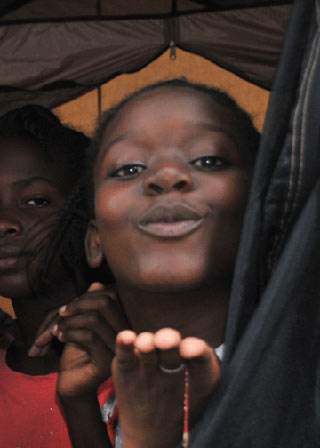
Copyright © Carole Devillers 2010
A young girl blows a kiss to the photographer in Port-au-Prince.
“The poorest country in the Western hemisphere”: that’s how Haiti has been described for many years. When a disaster of unimaginable proportions came crashing down on the tiny nation early this year, many wondered, “Can the Haitians endure?” After spending nearly two decades there and witnessing a variety of political, military, and climactic upheavals, I predict that they will grow even stronger from the tragedy. As Haitian writer René Depestre so rightly put it:
“Your people are hungry,
And sleepless, and they know
How to manage their sweat and tears.
Your people were forged
On the anvil of suffering.”
Certainly, Haiti is very poor by material standards, but my own eyes and heart as a photojournalist I found it much richer than many industrialized countries in its strong faith, its diverse creativity, and its powerful culture. Haitians are billionaires when it comes to resilience in face of adversity. Haiti is unique and full of beauty.
What struck me most when I first set foot on the island in 1976 was not the poverty or lack of roads, but the smiles. Aimed at the world like an antidote for their misery, smiles were everywhere–in the city as well as the countryside, around the corner, behind the few trees left on the island. And with them came unforgettable generosity and hospitality toward any stranger, even an obvious foreigner. Some 34 years later, I’m struck all the more by the enduring smiles, even when I see them in news clips of post-quake rescues.
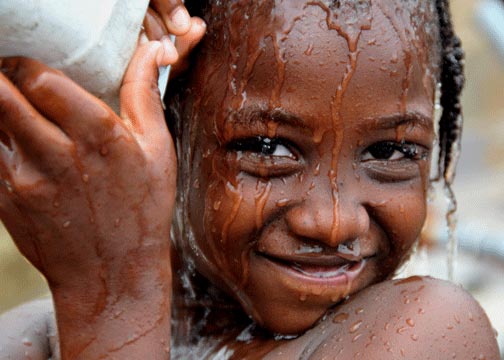
Copyright © Carole Devillers 2010
A smile from Haiti – from a little girl pouring a gallon of water over herself as a shower in her camp.
Smiles through Pain
After she spent six days under rubble, alone in the dark, her fingers pinned by a concrete block, a woman was finally discovered and asked through a little opening if she wanted water. She replied sweetly, “Water … yes … that would make me so happy.” Three hours later, when she was finally pulled out of what might have been her tomb, the woman beamed and burst into a song praising God. Likewise, a courageous five-year old boy has become an iconic image of the quake after being pulled from debris that entombed him for eleven days. With arms raised in a “V,” his face beamed like a bright light.
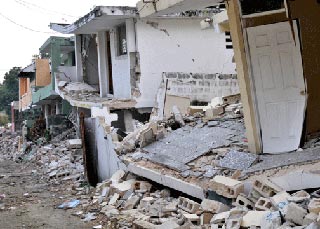
Copyright © Carole Devillers 2010
Destruction of a row of houses in a neighborhood street in Port-au-Prince.
The victims could be crying or wallowing in self-pity. Instead, Haitians sing to God. They could be defeated, but Haitians of all ages keep fighting. Perhaps they find it easier to battle a disaster once it’s personified. “This thing,” as they call the beast that tried to annihilate them on January 12, won’t have the best of them. “EQ Samson,” as they also call it, will not win. They’ve seen worse. What about their fight for independence 200 years ago–the first successful black slave rebellion? Their buildings and infrastructure may be down, but Haitians are up, their spirit still shining.
Generous in Adversity
After a few visits to Haiti on holidays, I was won over by the islanders’ kindness and resilience. I based myself in Port-au-Prince where I lived from 1982 to 2000. During that time I worked for 10 years with Reuters News Pictures as their photo correspondent. Covering the political turmoil of the 90’s, I was shot at by the army, had film confiscated, and survived some very tough moments. Each time we photographers were in trouble, Haitians came to our aid, giving us lemons when teargas was fired (soaking our bandannas with lemon juice helped us breathe better). They tried to protect us by indicating places to hide. Their gratitude was comforting. They trusted us out there on the front line to tell the story. We knew we could count on them to pull us through.
Over the years I came to know the community of Saut d’Eau. Its countryside is famous for its annual voodoo purification pilgrimage at the sacred waterfalls that brings thousands of people to the area for a few days each year . As there were no schools for the children there, a local villager offered some land he had leased, and I raised funds through the sale of photos. The offer to help the community build a primary school made the villagers ecstatic. Education was finally coming to their children.
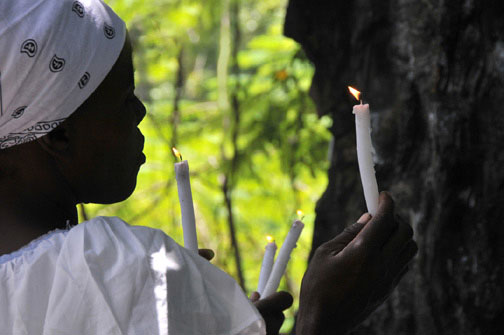
Copyright © Carole Devillers 2010
A pilgrim lights a candle during the Saut d’Eau annual purification pilgrimage.
What started then was a fantastic demonstration of communal work: parents, children, grandparents–everyone contributed. The school was built with rocks dug from the fields, carried in bags on horseback and on adults’ and children’s heads, all the way to the school site. Strong young men carried the logs necessary for the roof structure on their shoulders. Nobody spared any effort. Within a year, the school was built. More than 100 children, aged four to 15, were registered, and three out-of-work teachers from the area were put in charge of the school. The Center of Hope was born (1989). That’s how progress happens most of the time in Haiti. People have to do for themselves what their government can’t or won’t do for them. (To learn more about the Center of Hope, as its story does not end there, please visit PATCH-Haiti.)
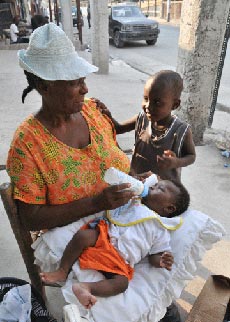
Copyright © Carole Devillers 2010
Ste Rose, whose house was destroyed in Port-au-Prince, sits in the street to give a milk bottle to her daughter’s baby, while another little grandson looks on. She’s on the list to receive a tent from PATCH.
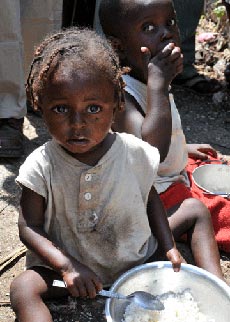
Copyright © Carole Devillers 2010
A toddler is fed a bowl of white rice in the camp of Thozin, outside of Port-au-Prince. The reddish tinge in his hair is a sign of malnutrition.
How to Help
With the government on its knees, individual Haitian volunteers are already at work rebuilding their country. History tells us they will find the strength to do it. Still, they’ll need help for years to come. The world has been very supportive, but how long will that assistance last before indifference sets in? The magnitude of the devastation is hard to fathom. Help will still be required long after news coverage and international attention ebbs.
I went to Haiti at the end of February and saw for myself hundreds of families still homeless and tentless, with nothing more than a bed sheet propped on wooden sticks for shelter. Thousands of victims still do not receive food. The living conditions in camps are dreadful. Yet, each time I came to a camp, people greeted me with smiles, happy with the attention I was showing them. (For more details, visit my BLOG.)
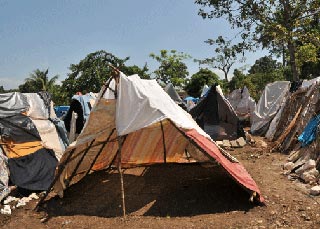
Copyright © Carole Devillers 2010
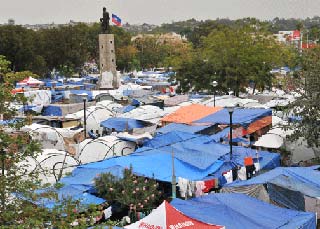
Copyright © Carole Devillers 2010
A camp of displaced victims in Thozin, outside of Port-au-Prince, is still made up of bed sheets propped on wooden sticks. During night rains, people say they can’t sleep and are forced to remain standing up as everything is soaked.
Petion Camp: A sea of tents and tarps surrounds the statue of Petion, first president of Haiti in the Champs de Mars in Port-au-Prince.
Millions of dollars have already been donated to the cause, but many of these funds cannot be immediately disbursed where they’re most urgently needed. Established Haitian grassroots organizations are able to provide direct, person-to-person aid to victims right away. I support OREworld (Organization for the Rehabilitation of the Environment), which has been working in Haiti’s countryside for 25 years and is a trustworthy and reliable non-governmental organization, recognized internationally. ORE has been able to evacuate 726 people from Port-au-Prince and provide shelter for the homeless, together with medical attention and food for those in need. What’s more, the organization buys nutritious food locally from farmers and country markets, keeping the economy alive. The food is then distributed to three identified refugee camps in Port-au-Prince. However, the situation is still critical for many in Port-au-Prince.
My own very modest program PATCH-Haiti (Photography in Aid To Children of Haiti) is a post-earthquake photo project: “THROUGH THEIR EYES: How Children of Haiti See Their World.” The goal is to provide therapy through the creative process of photography to children who were victims of the earthquake. The idea came from a child who asked me for a camera when I was in Haiti last. Basic digital point-and-shoot cameras and a tutorial will be given to children in Port-au-Prince. Besides the therapeutic benefit of photography, exhibits of their pictures will be organized in Haiti and in the US. Of course, the more cameras we gather, the wider our reach, and you can help. If you have a basic point-and-shoot digital camera sleeping in a drawer (but still working!) that you no longer use, it can enjoy a second life and be put to good use through our project. Please consider donating it (with a digital card)–contact the “Through Their Eyes” project. It will be most appreciated. Because of its inner strength and courage, kindness and resilience, I believe Haiti will be reborn from its ashes to surprise the whole world.
by Carole Devillers

Hello,I’m a fan of this site,and I find you story exciting and interesting .The more captivating ones are the beautiful photos I see on this site.
I’m an artist,though I’m still learning,I’m in love with the photo of the Haitian girl pouring water on her face. please I seek your permission to do a painting with that photo.I will be so excited if you permit me.Thanks.
Hello,I’m a fan of this site,and I must confess you guys are very good,exciting reports,fascinating photographs,and many more.
I’m an artist, though still learning. I’m in love with the photograph of the Haitian girl pouring water on her face, and am pleading for your permission to do a painting with that photo.I will be so excited if I get the permission. Thanks.